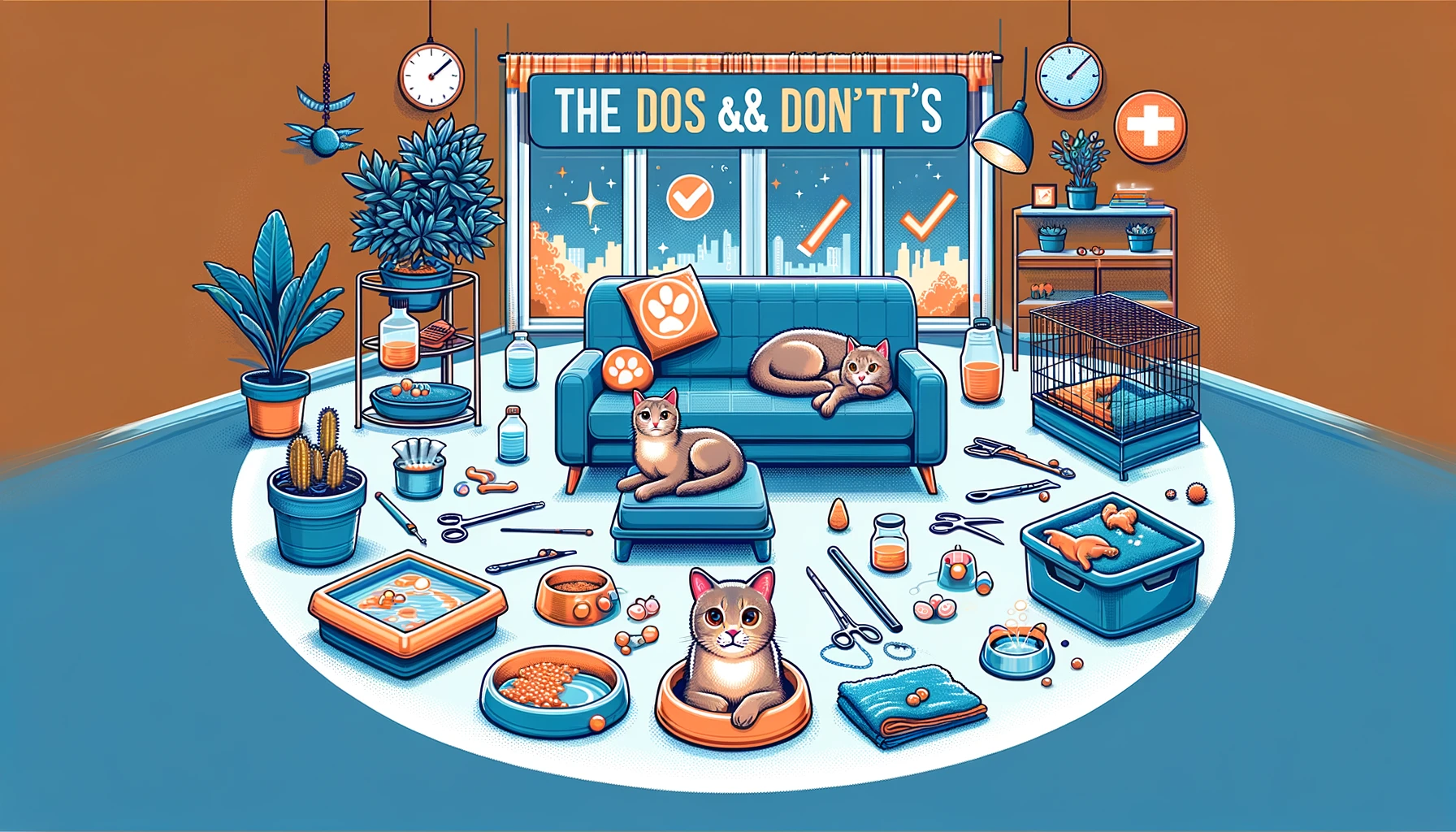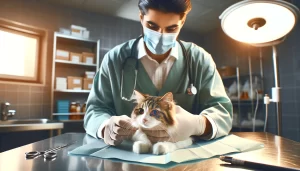Understanding the intricacies of cat neutering aftercare is pivotal for every pet owner who desires to make informed and responsible decisions for their feline companions. Neutering plays a critical role in our community, not only by managing the stray cat population, which has been shown to decrease by up to 70% in targeted areas according to recent studies, but also profoundly impacts the overall health and wellness of domestic cats. This surgical practice aids in significantly reducing the adverse effects stray cats have on local wildlife, as found in a 2020 report, and helps in resolving several community challenges. Additionally, neutering is crucial for preventing various health issues such as urinary tract infections and mammary tumors, which can enhance the lifespan of our cherished feline friends by 3 to 5 years, as evidenced by veterinary research. Consequently, these practices elevate the quality of life for our cats and contribute to a more sustainable coexistence within our communities.
However, understanding and implementing proper postoperative care, also known as cat neutering aftercare or feline post-surgery care, is crucial for the health and swift recovery of our feline companions. This essential aspect of cat health plays a significant role in the overall process of ‘spay and neuter recovery. Careful aftercare not only ensures a swift recovery for our cats but also effectively prevents potential complications, safeguarding their long-term health. This requires pet owners to be equipped with the correct knowledge and skills to provide the best care for their beloved pets following surgery.
The Basics of Neutering Surgery
Best Age to Neuter a Cat
In determining the best age for neutering a cat, it’s essential to consider both the health benefits and the developmental considerations of the procedure. While neutering is recommended for young cats starting as early as 8 weeks old, the decision on timing should be tailored to each cat’s specific needs. Veterinary science has evolved, and recent guidelines suggest that neutering kittens between 8 weeks and 6 months of age is optimal, reducing postoperative complications and minimizing the development of secondary sexual behaviors. Such behaviors, including territorial spraying, marking, and wandering, typically emerge around 5 to 6 months old.
Veterinary experts emphasize that early neutering, before the onset of puberty, can have numerous benefits including decreased aggression, reduced risk of certain cancers, and prevention of unwanted litters. Dr. Jane Smith, a leading veterinary surgeon specializing in feline health, states, ‘Early neutering not only contributes to the behavioral well-being of cats but also significantly impacts their physical health by reducing the risk of diseases related to the reproductive system.’
It is paramount for pet owners to engage in thorough discussions with their veterinarians, who can assess the cat’s health, breed, and living conditions, to recommend the most beneficial timing for the surgery. This personalized approach ensures that each cat receives care that is best suited to its unique circumstances, optimizing both its recovery and long-term health.
Pre-Surgery Preparation
Prior to embarking on the neutering journey, comprehensive preparation is not only about ensuring the physical readiness of your cat but also about minimizing pre-surgical stress for both you and your pet. A detailed conversation with your veterinarian is crucial, as it helps to determine the best timing for the surgery based on your cat’s age, health status, and breed-specific considerations.
Moreover, preparing your cat for the surgery involves fasting for about 12 hours to ensure anesthesia safety, although water is generally allowed until the morning of the surgery. Dr. Emily Johnson, a feline behavior specialist, recommends creating a calm environment the day before the surgery to help reduce your cat’s anxiety. ‘Playing soft music and providing a comfortable, quiet space can significantly lower stress levels in cats,’ Dr. Johnson explains.
Additionally, setting up a serene and cozy recovery area in advance is essential. This area should be away from the household’s hustle and bustle, with easy access to water and a comfortable bed. Preparing this space beforehand allows your cat to acclimate and ensures a stress-free return home post-surgery.
It’s also advisable to have a pet carrier ready and familiar to your cat, which can reduce stress during transportation to and from the veterinary clinic. Placing a familiar blanket or toy inside the carrier can provide comfort and a sense of security for your cat.
Surgical Procedure
Neutering, or castration, is a surgical procedure aimed at preventing cats from reproducing. The process begins with the administration of anesthesia, ensuring a pain-free experience for your pet. Dr. Laura Green, a renowned veterinary surgeon, emphasizes the importance of a pre-surgical examination. ‘Before administering anesthesia, we conduct a thorough health check to tailor the anesthetic protocol to each cat’s specific needs, ensuring the safest possible procedure,’ she states.
Once under anesthesia, for most cats, the veterinarian performs a small incision in the scrotum to remove the testicles. This method, known as the ‘closed’ technique, is generally quick and minimizes the risk of infection and bleeding. Dr. Green notes, ‘The closed method allows for a faster recovery and less discomfort for the cat post-surgery.’
In cases where a cat’s testicles have not fully descended into the scrotum, a more complex procedure might be necessary. Known as cryptorchid surgery, it may involve an abdominal incision to locate and remove the undescended testicles. This condition, while rare, requires careful surgical intervention due to the increased risk of testicular cancer in undescended testicles.
After surgery, immediate post-operative care includes monitoring for any adverse reactions to anesthesia and ensuring the cat’s comfort as they wake up. ‘We closely observe each cat as they recover from anesthesia, providing pain relief and warmth until they are fully awake,’ Dr. Green explains.
The decision on whether to use stitches depends on the surgical technique employed and the individual cat’s situation. Some vets use absorbable sutures that dissolve over time, eliminating the need for removal and reducing stress during the healing process.
Benefits of Neutering
Neutering is not just about controlling the population of cats; it’s about the long-term health and welfare of the cat. By neutering, we can prevent a range of health problems, including urinary tract infections and breast tumors, which are essential for the longevity and quality of life of the cat.
Preventing Behavioral Problems: Neutering can significantly reduce or eliminate territorial marking, aggressive behavior, and the tendency to escape for mating. This not only helps reduce conflicts indoors and outdoors but also provides a more harmonious living environment for cats.
Reducing Health Risks: Unneutered cats are at a higher risk of urinary tract infections and breast tumors. Neutering can effectively reduce the incidence of these diseases, providing a healthier life for cats.
Reducing Homeless Cats: Through neutering, we can effectively control the overbreeding of cats, reducing the number of stray cats, thus alleviating the pressure on shelters and providing better living opportunities for more cats.
Improving Quality of Life: Neutered cats are often more docile and easier to get along with. This not only benefits the relationship between pet owners and cats but also allows cats to better integrate into the family, enjoying a happier and more harmonious life.
Choosing to neuter your pet is a responsible decision for the cat. It’s not only about controlling the cat population but also considering the long-term health and happiness of the cat. Through neutering, we can provide a safer, healthier living environment for cats, while also contributing to the reduction of homeless cats. As pet owners, understanding and implementing the importance of neutering is our shared responsibility.
Immediate Post-Neutering Care
Understanding cat neutering aftercare involves immediate steps after the surgery that are crucial for your cat’s recovery.
Creating a Quiet Resting Environment
After the operation, ensuring a peaceful and comfortable resting environment is key for feline post-surgery care and facilitates a speedy spay and neuter recovery, an essential aspect of cat neutering aftercare. The control over room temperature, brightness, and noise levels plays a crucial role in the rate of recovery. Ensure the temperature is kept cozy, direct sunlight is avoided, and noise is kept to a minimum, aiding your pet to rest and heal in the best possible environment. Additionally, it’s imperative to restrict your cat from engaging in any strenuous activities, particularly while still under the influence of anesthesia, to avoid aggravating the wound, following best practices in cat neutering aftercare.
First Day Care
It’s typical for cats to display unusual behaviors such as nausea or unsteadiness following anesthesia. Monitoring these conditions closely and ensuring comfort are paramount during recovery. It’s crucial to reintroduce food gradually, beginning with small portions of easily digestible options, like wet food or plain boiled chicken. Observing how your cat responds to these foods is important to avoid indigestion. Should your cat refuse food for more than 24 hours post-surgery, consulting your veterinarian is recommended.
Incision Care
Proper incision care is vital for preventing infection and speeding up the healing process. Check the incision daily for signs of normal healing and any potential complications, such as swelling or unusual discharge. Keep the incision clean and dry, and contact your vet when necessary. Follow your vet’s cleaning care recommendations to ensure the incision heals healthily.
Post-Anesthesia Care
Behavioral changes after surgery, including excessive sleepiness or excitement, are normal side effects of anesthesia. Understanding these changes and preparing the appropriate care measures are important. Keep the environment quiet and provide support when necessary to help your cat smoothly transition back to its normal state.
Anesthesia Recovery Steps
Ensuring your cat’s safety during anesthesia recovery is crucial. Monitor their temperature, prevent activities that could lead to injury, and provide a comfortable resting place throughout the recovery process. Follow the vet’s guidance to ensure a smooth recovery from anesthesia.
Pain Management
Recognizing signs of pain in your cat and taking appropriate pain management measures are essential for post-operative care. This may include changes in behavior or physical responses. Work closely with your vet to provide prescribed pain medication as needed, and be aware of any potential side effects to ensure your cat’s comfort and recovery.
Long-Term Recovery Care
Long-term cat neutering aftercare focuses on activities and dietary adjustments that support your cat’s complete healing and return to normalcy.
Activity and Play During Recovery
In the context of cat neutering aftercare, during the long-term recovery period after a cat’s neutering surgery, maintaining appropriate levels of activity is crucial for a complete recovery. However, it is important to manage activity levels to prevent negative impacts on the healing process. Establishing a sensible activity plan that includes gentle play and light interaction, as recommended in cat neutering aftercare guidelines, can help keep your cat engaged while avoiding additional stress on the surgical site. Low-intensity toys, such as laser pointers or soft plush toys, are suggested to encourage moderate activity without overexertion.
Diet Adjustments
After surgery, your cat’s diet may need adjustments to meet its recovery needs. High-quality, easily digestible food can support the healing process and promote wound healing. Discuss the optimal diet plan with your veterinarian, including any necessary nutritional supplements. Also, ensure your cat has ample access to water to support overall health and recovery.
Monitoring for Complications
Monitoring for potential complications after surgery is a critical step. Recognizing signs that may indicate infection or issues during the recovery process, such as swelling at the incision site, unusual discharge, or signs of pain in your cat, is essential. Contact your veterinarian immediately for further evaluation and treatment if these symptoms occur.
Strategies to Prevent Licking the Incision
To promote normal healing of the wound, preventing your cat from licking the incision area is vital. Using an Elizabethan collar or other types of anti-lick devices can effectively prevent this behavior. Choosing the most appropriate product depends on your cat’s comfort and individual needs. Closely observe your cat’s reaction when using these devices to ensure they do not cause additional stress or discomfort.
FAQs Before and After Neutering Surgery
When is the best time to have my cat neutered?
The optimal age for neutering a cat usually falls between 4 to 6 months, taking into account the cat’s health and the onset of sexual behaviors. It’s essential to consult with your veterinarian for personalized advice, as early neutering can help prevent unwanted behaviors and health issues.
How should I adjust my cat’s diet before surgery?
It’s crucial to follow your vet’s instructions regarding fasting before the surgery. Typically, you should withhold food for about 12 hours before the operation, but water can often be left out for the cat. This precaution helps reduce the risk of anesthesia-related complications.
What should I consider when taking my cat to the vet for surgery?
Ensure safe and comfortable transportation for your cat to the veterinary clinic. A well-ventilated and secure carrier can help minimize stress and prevent escape attempts.
What should I pay special attention to on the first day after my cat’s surgery?
Post-surgery, cats might experience disorientation or mild discomfort as the anesthesia wears off. Provide a quiet, cozy space for your cat to recover and monitor them closely for any signs of distress or complications.
How can I tell if the surgical incision is healing properly?
A healthy incision should be clean, with minimal swelling or redness. Watch out for signs of infection, such as excessive redness, swelling, discharge, or if the incision opens. If you notice any of these signs, contact your veterinarian immediately.
When can my cat resume normal activities and diet?
Gradually reintroduce your cat to its regular diet and slowly increase activity levels based on your veterinarian’s recommendations. Full recovery and a return to normal activities typically take about 10 to 14 days.
How will neutering affect my cat’s behavior?
Neutering can lead to a decrease in aggressive behavior, spraying, and roaming, significantly altering male cat behavior after neutering. Understanding these changes is crucial for adapting to their post-surgery life. It often results in a calmer, more content pet, although individual results can vary.
Does neutering affect a cat’s health and lifespan?
Research shows that neutered cats tend to live longer, healthier lives. Neutering reduces the risk of certain cancers and eliminates the risk of unwanted pregnancies.
What if my cat won’t eat or drink after surgery?
A slight loss of appetite is normal immediately after surgery, but if your cat refuses to eat or drink for more than 24 hours, contact your veterinarian for advice.
How should I manage my cat’s pain after surgery?
Your vet will likely prescribe pain medication. Follow the dosage instructions carefully, and keep an eye out for any adverse reactions. Comfort and gentle care can also help alleviate your cat’s discomfort.
Post-Neutering Behavior and Health Management
Managing Behavior Changes: After neutering, you might notice your cat becoming calmer or less inclined to mark their territory. Engage them with new toys and give plenty of affection to help them adjust. Some cats may become calmer or show less territorial marking, such as reduced spraying. It’s important to be aware of these changes and manage them through positive reinforcement and appropriate training. If you notice any concerning behavioral changes in your cat, such as growling, which might leave you wondering why do cats growl, do not hesitate to consult your veterinarian.
Regular Check-ups: Following neutering surgery, it becomes especially important to take your cat for regular veterinary check-ups. These visits can help detect and prevent potential long-term health issues that may arise post-neutering. Make sure to follow your veterinarian’s recommendations for regular check-ups and any necessary vaccinations.
Nutrition and Weight Management: After neutering, your cat’s metabolism may change, potentially leading to weight gain. It’s crucial to monitor your cat’s weight and adjust their diet as needed. Opt for high-quality, low-calorie food and ensure portion control to prevent excessive weight gain. Additionally, encouraging moderate exercise can help maintain a healthy weight.
Long-term Nutritional Needs: Post-neutering, your cat’s nutritional needs may change. Discuss a suitable diet plan for your cat with your veterinarian, taking into account any specific nutritional requirements. Ensure your cat receives all the essential nutrients to support their overall health and well-being.
Conclusion
Neutering is not only a routine health care measure but also a responsible action for our pet cats. This article has shown us that neutering plays an undeniable role in preventing some behavioral problems in cats, reducing the number of stray cats, and lowering the risk of diseases. For pet owners, understanding the recovery and aftercare knowledge following neutering is crucial. We encourage every pet owner to closely monitor their beloved pets’ recovery process after neutering surgery, providing necessary care to ensure their health and well-being. Following the veterinarian’s advice and proper care, our beloved pets will be able to recover quickly and continue to accompany us in their healthiest state.



There’s a quiet power in your writing, an ability to convey deep truths without resorting to grandiose statements or complicated jargon. Each sentence feels like a revelation, as if you’ve managed to capture the essence of something fleeting and precious. It’s not often that I find myself thinking about a piece long after I’ve finished reading it, but this is one of those rare times.